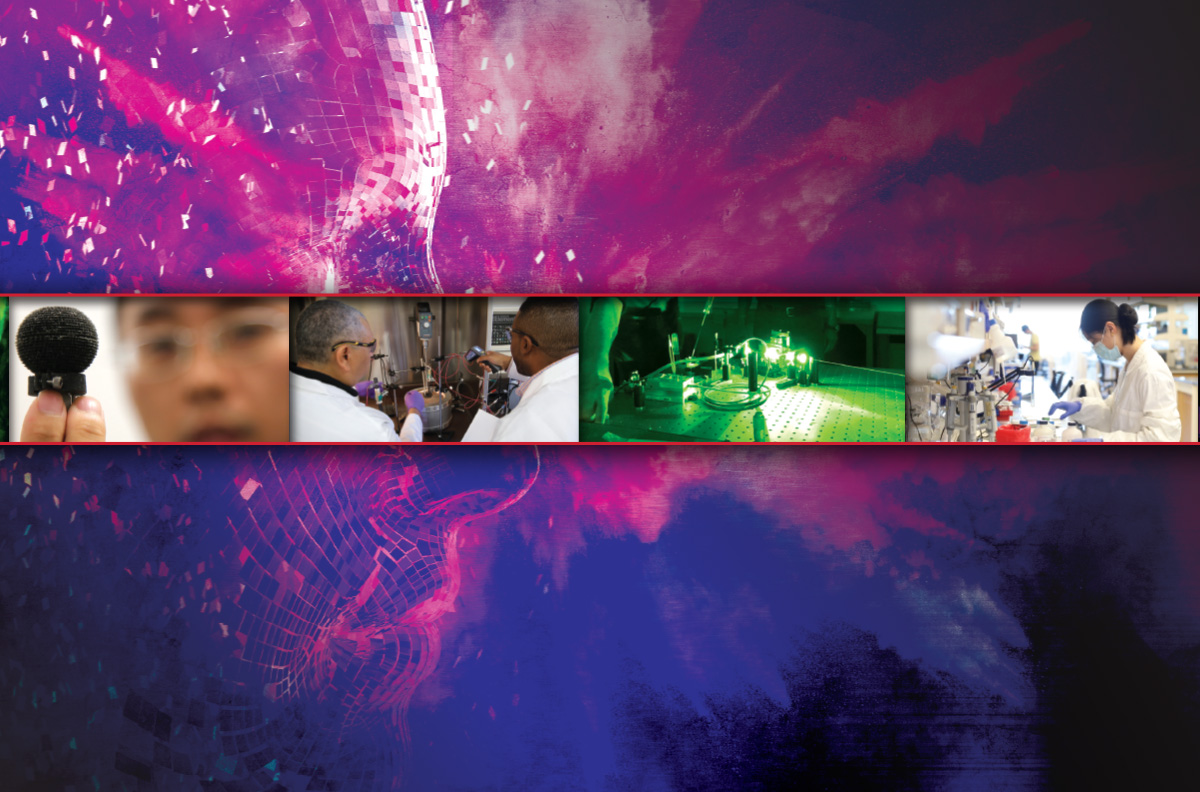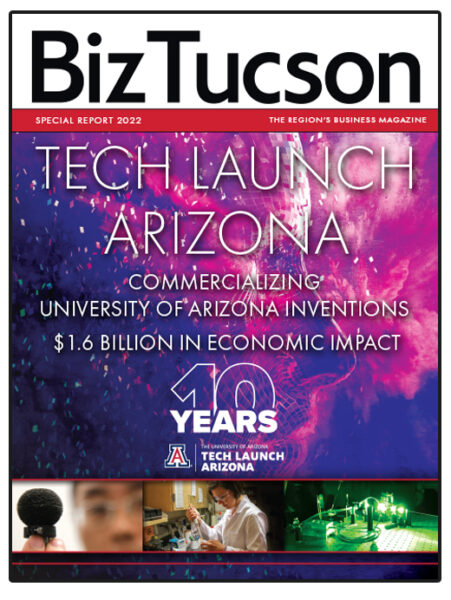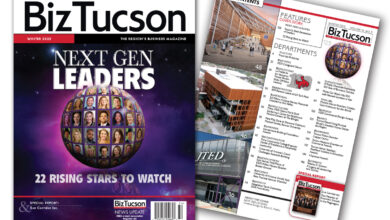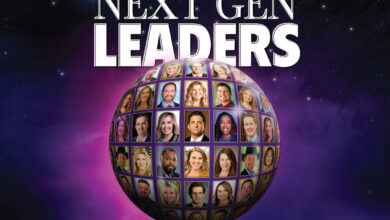
Tech Launch Arizona Marks a Decade
From UArizona Minds to Marketplace
By Jay Gonzales
In the not-so-distant past, ground-breaking research conducted on the University of Arizona campus more often than not was destined for one place – academic journals.
But since 2012, Tech Launch Arizona has pushed open the door to move life-changing technology and inventions on a path to the consumer market. It’s a turnaround in attitude and operation at UArizona which has resulted in benefits for multiple constituents – for consumers, for the university, for the researchers who devote their lives to their work, and for society.
“When TLA started, it was because university administration made a conscious decision to become as good at commercialization as it was at research,” said Associate VP Douglas Hockstad, who has led Tech Launch Arizona since 2018 when he was promoted to replace David Allen, the organization’s first vice president, who answered directly to the president of the UArizona. “We were a top-tier research university. “We were a top-tier research university, but we weren’t great at getting it out” into the market.
Fast forward to fiscal year 2021. During that year, TLA executed 124 licenses related to inventions originating from university research, had 100 patents issued, and started 17 new companies. Since TLA began operating, 128 companies have been formed to commercialize UArizona inventions.
In a report produced earlier this year, an independent consulting group estimated that in the five years from fiscal 2017 to fiscal 2021, TLA had supported about 2,500 jobs, and generated $1.6 billion in economic activity, including $561 million in labor income and $59 million in tax revenues.
TLA’s progress through the decade has been such that Tucson or the greater region, could develop into its own “Silicon Valley,” said Betsy Cantwell, senior VP for research, innovation and impact at UArizona where TLA resides in the campus organization structure. She’s not implying that Tucson will do what Silicon Valley does as an industry, but she said the region already has much of what it needs to build that type of “innovation ecosystem.”
“We’re not missing any pieces,” she said. “We’re just at the infancy stages in a lot of areas. But it’s all starting to bubble.”
Going commercial
Before TLA emerged to show the way to commercialization, the university’s brilliant researchers, for the most part, focused primarily on publication. There was little to no focus on commercialization or generating the societal benefit from research as the end game for their work. They had to be convinced.
“There were a lot of different moving parts that we were orchestrating,” said Allen, who was lured to UArizona from the University of Colorado where he ran its technology transfer arm. “The sum of it is the faculty and the community were ready, and the new administration came in and said, ‘Here are the keys to the car. You go drive.’
“We laid down the roadmap of where we were going and we just gradually turned around the ship. But it doesn’t turn around quickly.”
Hockstad said faculty at the time were not focused on or trained to think that their work might have monetary value or a potentially huge impact on society.
“It’s true everywhere that as faculty are being trained, as they’re getting their Ph.D.s and they’re doing their early research, they learn to focus on publication rather than translation,” Hockstad said. “What’s drilled into them is to publish to become recognized.”
Beacon of success
Allen and Hockstad engaged local businessman Fletcher McCusker and his lifetime business partner Michael Deitch in the establishment of TLA, and they “scoured” the university for a technology that could become a beacon for what they hoped to achieve. McCusker and Deitch were fresh from the sale of a billion-dollar company they had taken public.
“There was a small group of us who really believed,” McCusker said. “Doug Hockstad was a believer. He saw it happen at Michigan. (UArizona President) Bobby Robbins was a believer. He saw it happen at Stanford. Betsy Cantwell was a believer. She knew that you could meet the goals of both research and commercial activity. That small group of tenacious people just wouldn’t let go of the dog bone, and I think faculty members were won over and they saw the opportunities they created for them.”
The search for a marketable technology uncovered medical software developed at the R. Ken Coit College of Pharmacy designed to help insurance payers and physicians track and monitor prescriptions to mitigate dangerous drug interactions. The technology developed by UArizona researcher Kevin Boesen attracted $4 million in investment and a company was formed. That company, SinfoníaRx, was sold in 2017 for $130 million.
“I think people were skeptical until they saw our first couple of exits,” McCusker said. “We’ve truly made a dozen or more faculty into millionaires because they’ve been able to advance their company.”
Over time, Hockstad said, campus researchers have come to understand the possibilities of their work. They don’t always have an eye toward commercialization or a goal of getting rich, he said. But as they see the success stories of fellow faculty members, they become more aware of what TLA can do for them and their inventions.
“I don’t know if there ever was a line in the sand that we crossed” to demonstrate what Tech Launch Arizona can do, Hockstad said. “The difference is that when we started, more or less everyone that we talked to felt that we had a lot to prove. Now, I would say, the majority feeling on campus isn’t that we have a lot to prove, it’s about how we can help them and work them through the process.”
A marketing team headed by Paul Tumarkin has been instrumental in conveying the message that TLA is there to help.
“We’re making sure that we’re telling the right story internally at the university, that we’re reaching out to faculty and helping them understand what we do and how we can help them,” said Tumarkin, assistant director for marketing and communications. “We survey our inventors every year and the vast majority are happy with the service we provide and would recommend working with us to their colleagues. The next phase for us is to ensure that we continue to grow the numbers of university innovators engaged in the process and keep evolving our innovation culture.”
One-stop shop
Together, Allen and Hockstad built a one-stop shop for faculty members doing research and any UA staffers engaged in innovation that might have a commercial market. One of the key moves was embedding TLA licensing managers in the colleges where intellectual property – or IP – is produced, such as the colleges of Engineering, Optical Sciences, Medicine, Science, and Life Sciences and Agriculture, said Rakhi Gibbons, director of licensing for TLA.
These specialized team members are physically located in the colleges’ offices and are close advisers to the faculty. They also keep an eye out for work that might have legs in the market.
“The licensing managers, because they’re embedded, usually have a pretty good idea what the faculty and the college are working on,” Gibbons said. “They’re there, walking the halls with them. So, we start with a conversation. We sit down with the researcher and we talk about what they’re working on. And then our job is to think about that research and find an application for it that could benefit the public in some way.”
There are many ways that inventions get to market with the help of TLA. After first performing some due diligence on the invention, the technology can be protected with a patent, copyright or trademark. The rights to the technology can then be licensed to a company – either a startup or an existing company – that will carry on continued development and, eventually, produce a product. If a startup is the best path, the inventor will typically take a role in that company, possibly as a leader or as a technology adviser while a more experienced executive runs the new company.
Because great researchers are not always savvy entrepreneurs, TLA licensing managers walk them through the process from start to finish, from hiring attorneys to handle the legalities of everything from company formation and governance to filing IP protection to licensing agreements.
“The licensing managers are involved throughout that entire continuum,” Gibbons said. “Once we’ve identified a company, the licensing manager leads the transaction, eventually resulting in a license agreement. A license agreement gives a company the right to use our patents for that particular technology, to go and commercialize it.”
If the decision is to take the invention to market via a startup rather than a license to an existing company, a group headed by Bruce Burgess, director of venture development, steps in and works on a plan to form a strong startup team that can lead the company and raise the venture capital needed.
The expertise in this area is specific, said Burgess, a longtime entrepreneur with a number of startups under his belt. For the most part, it’s expertise that the faculty members don’t have.
“They may say, ‘I’ve thought about possibly starting a company around this, but I really don’t know how,’ ” Burgess said. “That’s where the licensing manager will tap me on the shoulder and say the faculty member would really like to have a conversation, and we’ll sit down and start to have that dialogue.”
During the whole process, TLA staff examines everything from assessing the viability of an invention, its uniqueness in the patent landscape, whether it can be protected and how, and whether there’s a market.
Hockstad said, “We make a concerted effort to make people feel comfortable – to help them understand our support and provide insight into intellectual property and the opportunities for impact available through commercialization.”






